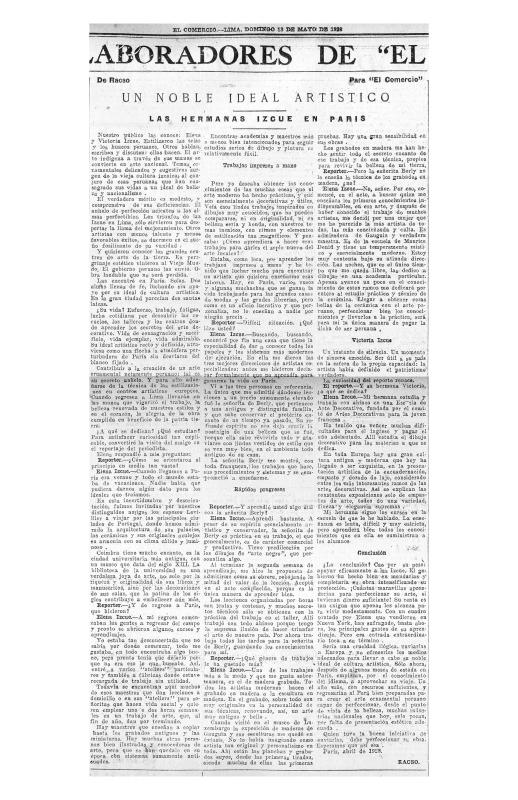This is an interview with Peruvian artists Elena and Victoria Izcue on their return to Peru in 1939 after twelve years living in France and the United States. In the 1920s a modern movement began to recuperate pre-Columbian aesthetic, indicating the archaeological development in Peru and the search of sources of national identity advocated by indigenism at that time. There is an interest by artists, researchers and intellectuals in using Pre-Columbian motifs and adapt them into the decorative and functional arts of the contemporary life. The artist Elena Izcue was instrumental in this movement. Not being followers of the indigenous group led by José Sabogal (1888–1956), they highlight their works with textile designs of applied arts and link their works with the fashion industry of Paris and New York. In 1927, thanks to a two-year pension granted to them by the Peruvian state, Elena and her sister Victoria would travel to the French capital to consolidate their artistic studies. In various workshops and factories abroad they achieved a successful career in the field of decorative arts, using printed fabrics with designs inspired by pre-Hispanic art. Their pieces were purchased by the prestigious House of Worth, fashion houses and private clients. In 1935 they travelled to New York and, thanks to the philanthropist Anne Morgan (1873–1952), presented the exhibition on Modern Art by Elena and Victoria Izcue, with textiles and Pre-Inca ceramics in the galleries of the Fuller building. After the exhibition, they stayed in the city for a few months filling out orders for different firms. In the middle of 1936, they returned to Paris and retook designing fabrics. They were summoned to decorate the Peruvian Pavilion at the International Exposition [of Art and Technology in Modern Life] in 1937 with maquettes, photographs and industrial exhibitions that gave a modern image of Peru, as well as works by contemporary artists. Additionally, in the honorable hall, the works by the Izcues and their Pre-Hispanic pieces were exhibited. In 1938, due to the imminent threat of the Second World War, the Izcue sisters decided to return to Peru while passing through to New York. It was while in New York when they were commissioned to accessorize the décor for the Peruvian Pavilion at the World Fair, with the intent to disseminate the public and social art works created under the Government of President Benavides (1933–39), making the participation by the Izcues limited to the disposing the halls and the objects relating to the pavilion. In the middle of 1939 they arrived in Lima and in 1940 they opened the Taller Nacional de Artes Gráficas Aplicadas, a workshop under the direction of Elena and the administration of Victoria. From 1941, they developed an artisan project in the northern part of the country centered on works that were made by traditional knitted straw. In different cities schools/workshops were established under the advice of the Izcues, who sought to raise the artistic level of native original works, improving the finishes of the works and proposing new designs. Noticeable was the absence of the Pre-Colombian art motifs as their interest was in rescuing and perfecting the traditional methods and applying them to contemporary design. The Izcues concluded with their public functions at the beginning of the fifties. Elena would dedicate the last twenty years of her life to making textile designs, as well as drawings and paintings of more personal and intimate interests. [Please refer to the ICAA digital archive for the following texts on the subject : “El arte peruano en la escuela” by Elena Izcue (doc. no. 1146099); “Un noble ideal artístico: las hermanas Izcue en París” by De Racso (doc. no. 1144316); “Una artista peruana en París” by Elvira García and García (doc. no. 1144288); “Un loable esfuerzo por el arte incaico: Prólogo” by Ventura García Calderón (doc. no. 1144261); “En el Museo Nacional: un ensayo de decoración estilo incaico”, by Alberto J. Martínez (doc. no. 1144009); “Las señoritas Izcue y el arte del antiguo Perú,” by Rafael Larco Herrera (doc. no. 1143993); and “Manuel Piqueras Cotolí” by Manuel Solari Swayne (doc. no. 1141324)]. Also please refer to the study on Elena Izcue, El arte precolombino en la vida moderna” (Lima: MALI, 1999), written by Luis Eduardo Wuffarden and Natalia Majluf.







